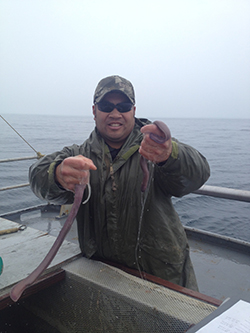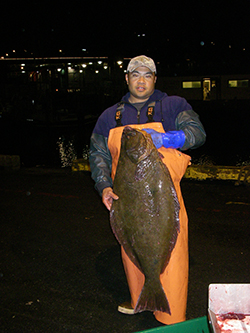
Travis Tanaka on a boat sampling “slime eels”

Travis holding a California Halibut
Travis Tanaka is an environmental scientist with nearly two decades of experience working for CDFW. As a marine scientist with the Marine Region based out of the Monterey office, his primary responsibilities include monitoring the California halibut and Pacific hagfish fisheries, as well as collecting data to help manage their take.
Where did you grow up?
Paso Robles. Growing up in Paso really didn’t influence my future with CDFW or my choice to be a consumptive outdoor enthusiast. My influences came from my father and grandfather. My father taught me to be a hunter and responsible gun owner at a young age. My grandfather was a commercial fisherman and introduced me to fishing for various groundfish species. He taught me to appreciate our ocean’s resources.
What led you to a career in marine biology?
While going through school, I wanted to pursue a career in wildlife management or resource law enforcement. However, my path changed following a college lecture where the professor spoke candidly about upcoming job market opportunities and the future of what we might expect regarding job pursuits within the field of wildlife management. He said the reality was that we would find a lack of work in wildlife management, but that there would be upcoming needs in marine science. After that I began taking extra coursework in marine science and fisheries. Since I’d grown up fishing with my grandfather, I already had a vested interest in fisheries and so taking additional coursework was easy. I had to rethink my interest in resource law once I realized I wouldn’t be able to pass the vision exam.
Tell us about your current research.
I am a staff member on the Northern/Central California Finfish Research and Management Project where we monitor and conduct research on state-managed Finfish species (e.g. California halibut, surf perch, smelt and Pacific hagfish.) My role is to work on California halibut and Pacific hagfish.
For halibut, I monitor the fishery within Monterey Bay. This includes sampling the Monterey area commercial hook-and-line fishery for length distribution and age composition. Early on, I used to go to recreational launch sites and sample the halibut catch from sport anglers. The California Recreational Fisheries Survey (CRFS) program has a great handle on the recreational fishery now, so I put my focus on the commercial end. I also lead the processing for all halibut otoliths our project collects through sampling for ageing. Otoliths, also known as ear bones, are a hard, bony structure important to the fish’s sensory system. Each year, the fish will add a layer, similar to tree rings. I am one of two readers of all halibut otoliths sampled by CDFW staff. To date, we have aged 4,000 California halibut. This age-at-length dataset is one of several datasets that were incorporated into our latest stock assessment. Our project has been collecting halibut data since 2007.
In 2008, I began sampling the hagfish fishery out of Moss Landing to monitor and increase our knowledge of this remerging fishery. I developed a count-per-pound metric to sample live hagfish at the dock. Live hagfish are impossible to measure due to their movement and slime production. Hagfish can’t be sexed externally. To get an estimate of average weight or size, we randomly fill a bucket with hagfish, weigh the bucket and then count back the contents. If this is done repeatedly throughout the tank, we can develop an estimate for average weight. If the average count number goes up, then the fish are smaller per count, and vice versa. The ideal count is around four fish per pound, based on market demand. We then document the average size of retained hagfish and collect life history information, as well as information on the market and its participants.
During a short period in the early 1990s, the Pacific hagfish fishery in California flourished to satisfy an export market for hagfish skins where they were used to create expensive leather-like products, such as boots, bags, wallets and purses. However, a market-induced crash later occurred, and the fishery went dormant. But by 2007, a renewed market demand emerged for the harvest of live hagfish for use as human food.
Part of my job also involves working with fishermen interested in designing new harvest gear. Recently, I worked with fishermen who wanted to use barrels as a new trap type for the take of hagfish. After the fishermen secured experimental gear permits, our project evaluated their new gear design. With assistance from a colleague, we performed the necessary observation trips to collect data on interactions and bycatch. At the same time, we also collected lab samples to document sex ratios and the spawning maturity of hagfish caught by these traps. Once all of the results were in, we approved their new trap type that will improve quality-of-catch, reduce the number of traps on the seafloor, and ultimately be a viable option to existing trap gear.
What are Pacific hagfish?
Pacific hagfish are primitive, spineless, deep-sea fish that lack jaws, true eyes or a stomach. They live in muddy sea floors. Hagfish dine by scavenging dead or dying fish and marine mammals. They enter their prey through any existing hole or orifice they can find, or by creating a new hole via their two pairs of rasping jaws. Once inside, they tear the flesh from the carcasses as they devour their prey from the inside out. When stressed, their defensive mechanism is to overwhelm any prospective predators by exuding a thick viscous slime. This behavior is the reason hagfish are commonly called “slime eels.” Today, Pacific hagfish are caught and sold for human food, and much of the harvest is shipped to markets overseas.
What is a typical day like for you at work?
It depends on if my work day is during my field season or not. My halibut field season runs approximately May-October. Hagfish work is year-round but is significantly slower in the winter. During the field season, halibut sampling occurs in the morning and then I spend the afternoons in the office editing commercial fishing receipts, entering data, or processing halibut otoliths for ageing. Local hagfish sampling occurs in the morning. Once per month I travel to Morro Bay and Port San Luis to sample the Pacific hagfish fisheries in those ports. During the halibut off season, the average day is spent in the office working on the backlog of halibut otoliths, keeping up with landing receipt editing or addressing any pending issues. I spend a significant amount of time answering questions from commercial fishermen and recreational anglers.
What is the most challenging aspect of your job?
The most challenging aspect of the job, for me and for many others in CDFW, is balancing the needs of the resources (halibut and hagfish) with the needs of those people that use it. Within the group that utilize a fishery, there are often conflicts due to allocation between the recreational and commercial sectors (although not for hagfish, for which there is no recreational fishery). Thus, I am required to spend a significant amount of time answering questions from commercial fishermen and recreational anglers over a broad range of marine resources questions. As a CDFW environmental scientist, I must consider and balance the ramifications and consequences (biological, economic, social) of regulations and management actions.
Tell us something about yourself that many people would be surprised to learn.
It’s not really a surprise, but if I were not a CDFW scientist, I would be working as a commercial fishermen and hunting guide. I have also created some fishing tutorial videos on “Recreational Crabbing” and “Rockfish and Lingcod Fishing Tips and Tricks.” All are now posted on CDFW’s website and have nearly 40,000 views!
Media contact: Carrie Wilson, Communications, (831) 649-7191
Photos courtesy of Travis Tanaka. Top Photo: Travis sampling "slime eels".